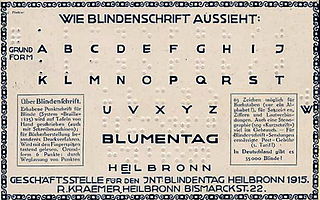
New York Point is a braille-like system of tactile writing for the blind invented by William Bell Wait (1839–1916), a teacher in the New York Institute for the Education of the Blind. The system used one to four pairs of points set side by side, each containing one or two dots. The most common letters are written with the fewest points, a strategy also employed by the competing American Braille.

Russian Braille is the braille alphabet of the Russian language. With suitable extensions, it is used for languages of neighboring countries that are written in Cyrillic in print, such as Ukrainian and Mongolian. It is based on the Latin transliteration of Cyrillic, with additional letters assigned idiosyncratically. In Russian, it is known as the Braille Script.
Arabic Braille is the braille alphabet for the Arabic language. It descends from a braille alphabet brought to Egypt by an English missionary prior to 1878, so the letter assignments generally correspond to English Braille and to the same romanization as in other braille systems, like Greek and Russian. However, there were once multiple standards, some of which were unrelated to Coptic Braille. A unified Arabic Braille was adopted in the 1950s as part of the move toward international braille, and it is the standard throughout the Arab world. Other Arabic-based alphabets have braille systems similar to Arabic Braille, such as Urdu and Persian Braille, but differ in some letter and diacritic assignments.

The Esperanto language has a dedicated braille alphabet. One Esperanto braille magazine, Esperanta Ligilo, has been published since 1904, and another, Aŭroro, since 1920.
Bulgarian Braille is a braille alphabet for writing the Bulgarian language. It is based on the unified international braille conventions, with braille letters approximating their Latin transliteration, and the same punctuation, with the French question mark. In Bulgarian, it is known as Брайлова азбука "braille alphabet".

French Braille is the original braille alphabet, and the basis of all others. The alphabetic order of French has become the basis of the international braille convention, used by most braille alphabets around the world. However, only the 25 basic letters of the French alphabet plus w have become internationalized; the additional letters are largely restricted to French Braille and the alphabets of some neighboring European countries.

German Braille is one of the older braille alphabets. The French-based order of the letter assignments was largely settled on with the 1878 convention that decided the standard for international braille. However, the assignments for German letters beyond the 26 of the basic Latin alphabet are mostly unrelated to French values.
Scandinavian Braille is a braille alphabet used, with differences in orthography and punctuation, for the languages of the mainland Nordic countries: Danish, Norwegian, Swedish, and Finnish. In a generally reduced form it is used for Greenlandic.
Portuguese Braille is the braille alphabet of the Portuguese language, both in Portugal and in Brazil. It is very close to French Braille, with slight modification of the accented letters and some differences in punctuation.
Māori Braille is the braille alphabet of the Māori language. It takes the letter wh from English Braille, and has an additional letter to mark long vowels. When Unified English Braille was adopted by New Zealand, it was determined that Māori Braille was compatible, and would continue to be used unchanged.
Urdu Braille is the braille alphabet used for Urdu. There are two standard braille alphabets for Urdu, one in Pakistan and the other in India. The Pakistani alphabet is based on Persian Braille and is in use throughout the country, while the Indian alphabet is based on national Bharati Braille.
Sinhala Braille is one of the many Bharati braille alphabets. While it largely conforms to the letter values of other Bharati alphabets, it diverges in the values of the letters assigned toward the end of those alphabets.
Ukrainian Braille is the braille alphabet of the Ukrainian language. It is based on Russian Braille, with a few additional letters found in the print Ukrainian alphabet.

Spanish Braille is the braille alphabet of Spanish and Galician. It is very close to French Braille, with the addition of a letter for ñ, slight modification of the accented letters and some differences in punctuation. Further conventions have been unified by the Latin American Blind Union, but differences with Spain remain.
Several braille alphabets are used in Ghana. For English, Unified English Braille has been adopted. Four other languages have been written in braille: Akan (Twi), Ga, Ewe, and Dagaare. All three alphabets are based on the basic braille letter values of basic Latin alphabet:
The braille alphabet used for the Kyrgyz language is based on Russian Braille, with a few additional letters found in the print Kyrgyz alphabet.
The braille alphabet used for the Kazakh language is based on Russian Braille, with several additional letters found in the print Kazakh alphabet.
Catalan Braille is the braille alphabet of the Catalan language. It is very close to French Braille: it uses the 26 letters of the basic braille alphabet, plus several additional letters for ç and what are, in print, vowel letters with diacritics; these differ from their French values only in the need to accommodate the Catalan acute accent: ú, ó, í for what are in French Braille ù, œ, ì :
Belarusian Braille is the braille alphabet of the Belarusian language. It is based on Russian Braille, with a couple additional letters found in the print Belarusian alphabet.
Navajo Braille is the braille alphabet of the Navajo language. It uses a subset of the letters of Unified English Braille, along with the punctuation and formatting of that standard. There are no contractions.





